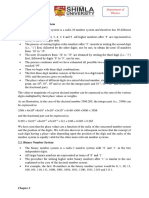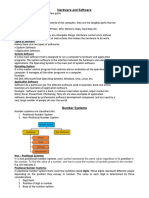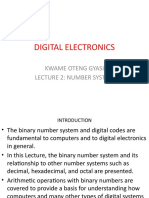Converting Between Decimal (Base 10) and Binary (Base 2)
Uploaded by
Chong Suk LeeConverting Between Decimal (Base 10) and Binary (Base 2)
Uploaded by
Chong Suk LeeConverting between Decimal (Base 10) and Binary (Base 2)
Base 10 vs. Base 2
Were used to thinking about numbers in base 10. People probably started using base 10 because we have 10 ngers so its easiest for us to count in groups of 10. In a base 10 (or decimal) number, each column in the number stands for a power of 10. Numbers have a 1s column (= 100 ), 10s column (= 101 ), 100s column(= 102 ), etc. We write numbers with the most signicant column (the one with the highest value) at the left. We can determine the value of number by multiplying the digit in the column by how much the column is worth:
1000 100 10 1 ---------------2 0 3 6 Total: 2 * 1000 + 0 * 100 + 3 * 10 + 6 * 1 = 2036
Were all used to working with base 10, but because information in a computer is stored in bits (just 0 or 1, so its kind of like just having two ngers to count on), its easiest to work in base 2. In a base 2 (or binary) number, each column stands for a power of 2: 20 (= 1), 21 (= 2), 22 (= 4), 23 (= 8), etc.
16 8 4 2 1 -----------------1 0 1 1 0 Total: 1 * 16 + 0 * 8 + 1 * 4 + 1 * 2 + 0 * 1 = 22
We will consider two methods for converting between decimal and binary numbers, the table method and the division/multiplication by 2 method.
Table Method
Decimal to Binary with a Table 1. Create a table whose leftmost column is the greatest power of 2 less than the number you want to convert. If the number is between 64 and 127, the leftmost column will be 64. If the number is between 128 and 255, the leftmost column will be 128. Each column in the table is a power of 2. The rightmost column is 20 (= 1), the next one to the left is 21 (= 2), the next is 22 (= 4), etc. Instead of thinking about powers of 2, you can just think about doubling each number to get the value for the next column to the left. This will typically look like:
64 32 16 8 4 2 1 --------------------------
2. Start by comparing the number you want to convert to the value leftmost column. If youve set up the table correctly, it should be less than the column value, so put a 1 in the column. 3. Add up the values of all the columns youve put 1s in so far. This is your running total. Take the running total and add the value of the next column. If the result is less than the number you want to convert, put a 1 in this column. If the result is greater than the number you want to convert, put a 0 in this column. 4. Repeat the previous step until all columns are lled.
Decimal number: 87 64 32 16 8 4 2 1 -------------------------1 0 1 0 1 1 1 Binary number: 1010111
(64 (64 (64 (64 (64 (64 (64
< + + + + + +
87 32 16 16 16 16 16
? < < + + + +
yes) 87 ? no) 87 ? yes) 8 < 87 ? no) 4 < 87 ? yes) 4 + 2 < 87 ? yes) 4 + 2 + 1 = 87, yes, done)
Decimal number: 105 64 32 16 8 4 2 1 -------------------------1 1 0 1 0 0 1 Binary number: 1101001
(64 (64 (64 (64 (64 (64 (64
< + + + + + +
105 ? yes) 32 < 105 ? yes) 32 + 16 < 105 ? no) 32 + 8 < 105 ? yes) 32 + 8 + 4 < 105? no) 32 + 8 + 2 < 105? no) 32 + 8 + 1 = 105, yes, done)
Binary to Decimal with a Table 1. Create a table with enough columns for your binary number. (See instructions in the previous section.)
64 32 16 8 4 2 1 --------------------------
2. Fill in the binary number in the table making sure that the rightmost digit is aligned under 1.
3. For each column containing a 1, take the value of that column (e.g., 64, 32, etc.) and add it to the total. Binary number: 1010111 64 32 16 8 4 2 1 -------------------------1 0 1 0 1 1 1 Total: 64 + 16 + 4 + 2 + 1 = 87
Binary number: 1101001 64 32 16 8 4 2 1 -------------------------1 1 0 1 0 0 1 Total: 64 + 32 + 8 + 1 = 105
Division/Multiplication by 2 Method
Decimal to Binary: Divide by 2 1. Take the decimal number and divide it by two keeping track of the remainder (instead of decimal place). For example, 10 / 2 is 5 r 0. 11 / 2 is 5 r 1. The result for both is 5. The remainder for 10 / 2 is 0 and the remainder for 11 / 2 is 1. 2. Take the result and divide it by two in the same way, always keeping track of the remainder. 3. Repeat Step 2 until you reach a result of 0. Your last step should always look like 1 / 2 = 0 r 1. 4. Read the remainders (all 0 or 1) o in reverse order starting at the bottom with the one you just nished. This is the answer.
Decimal number: 87 87 43 21 10 5 2 1 / / / / / / / 2 2 2 2 2 2 2 = 43 r 1 = 21 r 1 = 10 r 1 = 5 r 0 = 2 r 1 = 1 r 0 = 0 r 1 105 105 52 26 13 6 3 1 / / / / / / / 2 2 2 2 2 2 2 = 52 r 1 = 26 r 0 = 13 r 0 = 6 r 1 = 3 r 0 = 1 r 1 = 0 r 1
Result (read remainders bottom to top): 1010111 1101001
Binary to Decimal: Multiply by 2 1. Start with 0 as the result. Add to 0 the digit from the leftmost column in the binary number. 2. Take the result, multiply it by 2, and add the next digit following left-to-right in the binary number. 3. Repeat Step 2 until you have used all digits in the binary number. The nal result is your answer.
Binary number: 1010111 0 1 2 5 10 21 43 + + + + + + + 1 0 1 0 1 1 1 = = = = = = = 1 2 5 10 21 43 87 1101001 0 1 3 6 13 26 52 + + + + + + + 1 1 0 1 0 0 1 = 1 = 3 = 6 = 13 = 26 = 52 = 105
* * * * * *
2 2 2 2 2 2
* * * * * *
2 2 2 2 2 2
Decimal number: 87 105
Checks The best way to check your answer is to convert it back and make sure you get what you started with. A few quick checks might also help you catch mistakes: 1. If the decimal number is even, the equivalent binary number should end in 0. If the decimal number is odd, the binary number should end in 1. 2. If the binary number ends in 1, the equivalent decimal number should be odd. If the binary number ends in 0, the decimal should be even. 3. If the decimal number is between 64 and 127, the equivalent binary number should contain 7 digits (ignoring any leading 0s). 4. If the decimal number is between 128 and 255, the equivalent binary number should contain 8 digits (ignoring any leading 0s).
You might also like
- Conveconvconverting Between Decimal (Base 10) and Binary (Base 2)No ratings yetConveconvconverting Between Decimal (Base 10) and Binary (Base 2)26 pages
- Subnetting?! You Can Do It!: Example 1 (Binary To Decimal) 11001011 203 orNo ratings yetSubnetting?! You Can Do It!: Example 1 (Binary To Decimal) 11001011 203 or2 pages
- Object Oriented Programming in Java Binary and Hexadecimal Numeration and Logical OperationsNo ratings yetObject Oriented Programming in Java Binary and Hexadecimal Numeration and Logical Operations12 pages
- OCR a-Level Computer Science Spec Notes_ 1.4 SummarizedNo ratings yetOCR a-Level Computer Science Spec Notes_ 1.4 Summarized9 pages
- A Freshman C++ Programming Course: Dr. Ali H. Al-Saedi Mustansiriyah University, Baghdad, IraqNo ratings yetA Freshman C++ Programming Course: Dr. Ali H. Al-Saedi Mustansiriyah University, Baghdad, Iraq86 pages
- CMP 331 (Computer Architecture and Organization I)No ratings yetCMP 331 (Computer Architecture and Organization I)27 pages
- Number System: After Studying Chapter 1, You Should Be Able ToNo ratings yetNumber System: After Studying Chapter 1, You Should Be Able To9 pages
- Digital Electronics: Kwame Oteng Gyasi Lecture 2: Number SystemNo ratings yetDigital Electronics: Kwame Oteng Gyasi Lecture 2: Number System28 pages
- Worksheet on Number System, Data Compression, Transmission and HardwareNo ratings yetWorksheet on Number System, Data Compression, Transmission and Hardware6 pages
- Lab 1.5.9: Converting Numbers Overview: Estimated Time: 25 Minutes ObjectiveNo ratings yetLab 1.5.9: Converting Numbers Overview: Estimated Time: 25 Minutes Objective5 pages
- Computer Fundamentals: Instructor: Sehar Javaid Lecture # 04 & 05No ratings yetComputer Fundamentals: Instructor: Sehar Javaid Lecture # 04 & 0545 pages
- Conveconvconverting Between Decimal (Base 10) and Binary (Base 2)Conveconvconverting Between Decimal (Base 10) and Binary (Base 2)
- Subnetting?! You Can Do It!: Example 1 (Binary To Decimal) 11001011 203 orSubnetting?! You Can Do It!: Example 1 (Binary To Decimal) 11001011 203 or
- Object Oriented Programming in Java Binary and Hexadecimal Numeration and Logical OperationsObject Oriented Programming in Java Binary and Hexadecimal Numeration and Logical Operations
- OCR a-Level Computer Science Spec Notes_ 1.4 SummarizedOCR a-Level Computer Science Spec Notes_ 1.4 Summarized
- A Freshman C++ Programming Course: Dr. Ali H. Al-Saedi Mustansiriyah University, Baghdad, IraqA Freshman C++ Programming Course: Dr. Ali H. Al-Saedi Mustansiriyah University, Baghdad, Iraq
- CMP 331 (Computer Architecture and Organization I)CMP 331 (Computer Architecture and Organization I)
- Number System: After Studying Chapter 1, You Should Be Able ToNumber System: After Studying Chapter 1, You Should Be Able To
- Digital Electronics: Kwame Oteng Gyasi Lecture 2: Number SystemDigital Electronics: Kwame Oteng Gyasi Lecture 2: Number System
- Worksheet on Number System, Data Compression, Transmission and HardwareWorksheet on Number System, Data Compression, Transmission and Hardware
- Lab 1.5.9: Converting Numbers Overview: Estimated Time: 25 Minutes ObjectiveLab 1.5.9: Converting Numbers Overview: Estimated Time: 25 Minutes Objective
- Computer Fundamentals: Instructor: Sehar Javaid Lecture # 04 & 05Computer Fundamentals: Instructor: Sehar Javaid Lecture # 04 & 05
- Master Fracions Addition, Subtraction And MultiplicationFrom EverandMaster Fracions Addition, Subtraction And Multiplication



























































